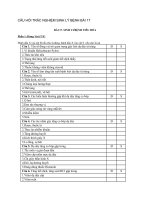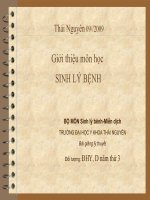Bài 16+17 sinh lý bệnh hệ tiêu hóa
Bạn đang xem bản rút gọn của tài liệu. Xem và tải ngay bản đầy đủ của tài liệu tại đây (1.59 MB, 39 trang )
Trần Khiêm Hùng
Mục tiêu:
-Áp dụng bệnh nguyên-bệnh sinh-phương pháp
thực nghiệm vào một số bệnh lý đường tiêu hóa
-Đề cập một số bệnh lý ở dạ dầy-ruột non dưới
góc độ sinh lý bệnh học
I.1.Loét dd là gì?
I.2.Nhắc lại giải phẫu sinh lý:
*Các yếu tố phá hủy:
*Các yếu tố bảo vệ:
I.3.Bệnh nguyên:
Có nhiều tranh luận và nảy sinh yếu tố mới theo
thời gian
+Schwarg nhận định “loét dạ dầy là hậu quả của
sự tự tiêu hóa”
+Schwarg “khộng acid khơng có lt”
+Giảm yếu tố bảo vệ: người già…
+…
+Vai trò HP (Helicobacter Pylori)
Vai trị Australian scientists Barry Marshall
(microbiology, uống) and Robin Warren
(pathologist)
Bài học gì?
Nobel Prize in Medicine 2005
II.1. Vài định nghĩa:
+Thế nào là tiêu chảy?
*Gia tăng số lần
*Phân có nhiều nước và lượng phân tăng hơn bình
thường (BT: Người Lớn 200g/Trẻ Con:100g).
Tuy nhiên!!!
+Phân độ:
*Cấp: dưới 2 tuần
*Mãn: trên 4 tuần
II.2.Cơ chế bệnh sinh
Osmotic diarrhea occurs when there is a
A.Tiêu chảy thẩm thấu
dysfunction in the ability of the intestine
to reabsorb fluid as it flows through the
lumen (Kent & Banks, 2010).
A person with osmotic diarrhea will have stool volume under one
liter per day, the stool will be acidic and more potassium will be lost than sodium (Bliss,
Doughty, Hietkemper, 2006).
B.Tiêu chảy tăng tiết dịch:
+Secretory diarrhea occurs when there is an
increase in the amount of fluid being drawn into
the lumen of the bowel such that the ability of the
intestines to reabsorb is
overwhelmed (Bliss, Doughty, Heitkemper, 2006).
+Infectious include Vibrio cholerae, E. coli,
Camylobacter jejuni,Salmonella, Shigella, and
Clostridium difficile (Farthing, 2006).
cystic fibrosis
transmembrane
conductance regulator
stool volume of more than one liter daily, with neutral pH and have no change in the
amount of stool produced with
fasting (Bliss, Doughty, Heitkemper, 2006)
C.Tiêu chảy tăng nhu động (rối loạn nhu động)
People with altered gut motility and diarrhea will have low volume, liquid stool
and cramping (Bliss, Doughty, Heitkemper, 2006).









